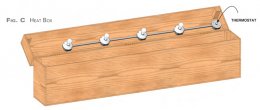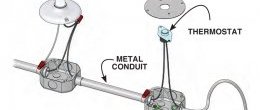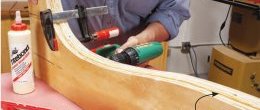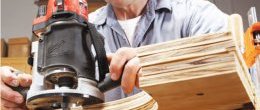Build your own recurve bow kit
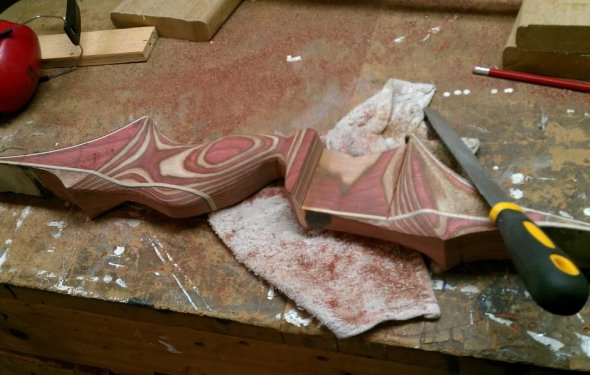
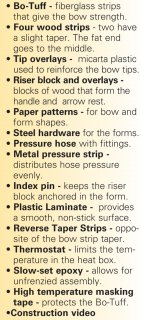 I got my first bow for my fourth birthday. It was plastic and thank heavens the arrows had rubber tips because everything within a 30-ft. radius was fair game. These days I exercise better judgement and only shoot at designated archery targets, but my fascination with this ancient technology is as strong as ever.
I got my first bow for my fourth birthday. It was plastic and thank heavens the arrows had rubber tips because everything within a 30-ft. radius was fair game. These days I exercise better judgement and only shoot at designated archery targets, but my fascination with this ancient technology is as strong as ever.
Several years ago I built my own wood and fiberglass recurve bow from a kit. The “recurve” refers to the way the bow curves away from the shooter at the tips. This gives the bow more snap when the arrow is released. Building the bow was almost as exciting as shooting it. Since then I’ve built several bows, each with a feel and character of its own. They’re beautiful to look at and fun to use. There aren’t too many woodworking projects you can play with outdoors!
A bow may look complex, but the kit I used makes it pretty straight forward. In this story, I’ll show you how to make a bow from one of these kits. No specialized tools are required, but you will need a bandsaw and an oscillating spindle sander to shape the bow. A drum sander in a drill press can substitute for the spindle sander.
The bow is laminated with thin strips of wood and fiberglass. They’re bent and glued together with epoxy using a plywood form. You don’t need a zillion clamps to squeeze the forms together, however. The kit’s manufacturer has a better idea: to apply clamping pressure, you inflate a fire hose with a bicycle pump. Then, you place the assembly in a shop-made plywood box equipped with incandescent light bulbs. The bulbs provide the heat necessary to cure the epoxy. The result is a one-piece recurve bow with incredible strength and flexibility.
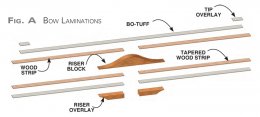 Build the forms
Build the forms
1. Use the full-size paper patterns from the kit
to lay out, cut and smooth one layer of plywood to
use as a template for the upper and lower halves
of the form (Fig. B, below).
2. Rough cut the other plywood layers about
1/8-in oversize.
3. Glue the layers together using 1-3/4-in.
screws as clamps (Photo 1). Use a wet rag to clean
away any squeeze out on the template edge. You
will need a smooth surface for the bit bearing to
ride on in the next step.
4. Once the glue is dry, use a router with a
flush-trim bit to trim the other pieces even with
the templates (Photo 2).
5. Drill a 1/4-in. hole in the center of the lower
form and drive in the steel riser index pin (Fig. B).
6. Glue the reverse taper strips (Fig. B) onto
the lower form. Butt the skinny end of each strip
against the index pin. The taper on these strips is
just the opposite of the taper on the bow lamination
strips and creates a better matched clamping
surface. Use contact cement for an instant bond
without clamps. Then, add strips of plastic laminate
to create a smooth surface (Photo 3). The
edge of the upper form does not contact the bow
laminations, so it needs no special treatment.
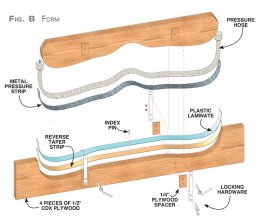 7. Install the locking hardware on the form
7. Install the locking hardware on the form
(Fig. B). Add spacers under the hardware to allow
room for the deflated hose.
8. Build the laminating oven using 1/2-in.
plywood with 2×2 corner cleats (Fig. C, below).
Assemble the box as one big unit, then cut the lid
free with a circular saw.
9. Wire in the porcelain light bulb sockets and
the thermostat (Fig. D, below). I lined the box with
thin-foiled insulation, but that’s optional.
Prep the laminations
10. Cut the riser block to length. Find the center
of the bottom of the riser block and drill a 5/16-
in. hole, 1/2-in. deep to fit over the index pin on
the lower form. Trace the shape of the riser using
the pattern in the kit and cut the shape using your
bandsaw. Sand with a drum sander (Photo 4).
11.Trim the wood laminations to 32-in. Then,
cook the riser and wood laminations in the heat
box for about 30 minutes to chase off any surface
moisture that might interfere with the epoxy set.
12. Cut both bottom pieces of Bo-Tuff fiberglass
to 32-in. and the top piece to 64-in. A Dremel cutoff
disc works great on the Bo-Tuff, but a pair of
metal cutting shears will do. Wear gloves when handling
the Bo-Tuff. Fiberglass slivers are a real drag.
13. The Bo-Tuff has a smooth and a rough side.
The smooth side is the finished surface while the
rough side gets the epoxy. Apply heat-resistant
masking tape to the smooth side of the Bo-Tuff.
The masking tape keeps epoxy off the surface and
avoids unnecessary cleaning and sanding
14. It’s imperative to have everything (including
a helper) ready before applying epoxy to the bow
laminations. I like to set the form between blocks
clamped to a pair of sawhorses. This provides clearance
around the entire form so I can wrap filament
tape around the form and pull the laminations
down tight to the form. Test the pressure hose fittings
for leaks in a pail of water just as you would
with a bicycle inner tube. Also, rub a thin layer of
paste wax onto the plastic laminate and both sides
of the metal pressure strip (Fig. B) to keep oozing
epoxy from sticking to their surfaces.
15. Roll out an ample length of plastic wrap over
the lower form onto the plastic laminate to further
protect it from epoxy squeeze out.
16. Lay all the lamination pieces onto a papered
surface in pairs. Mix about 4 oz. of epoxy in a small
